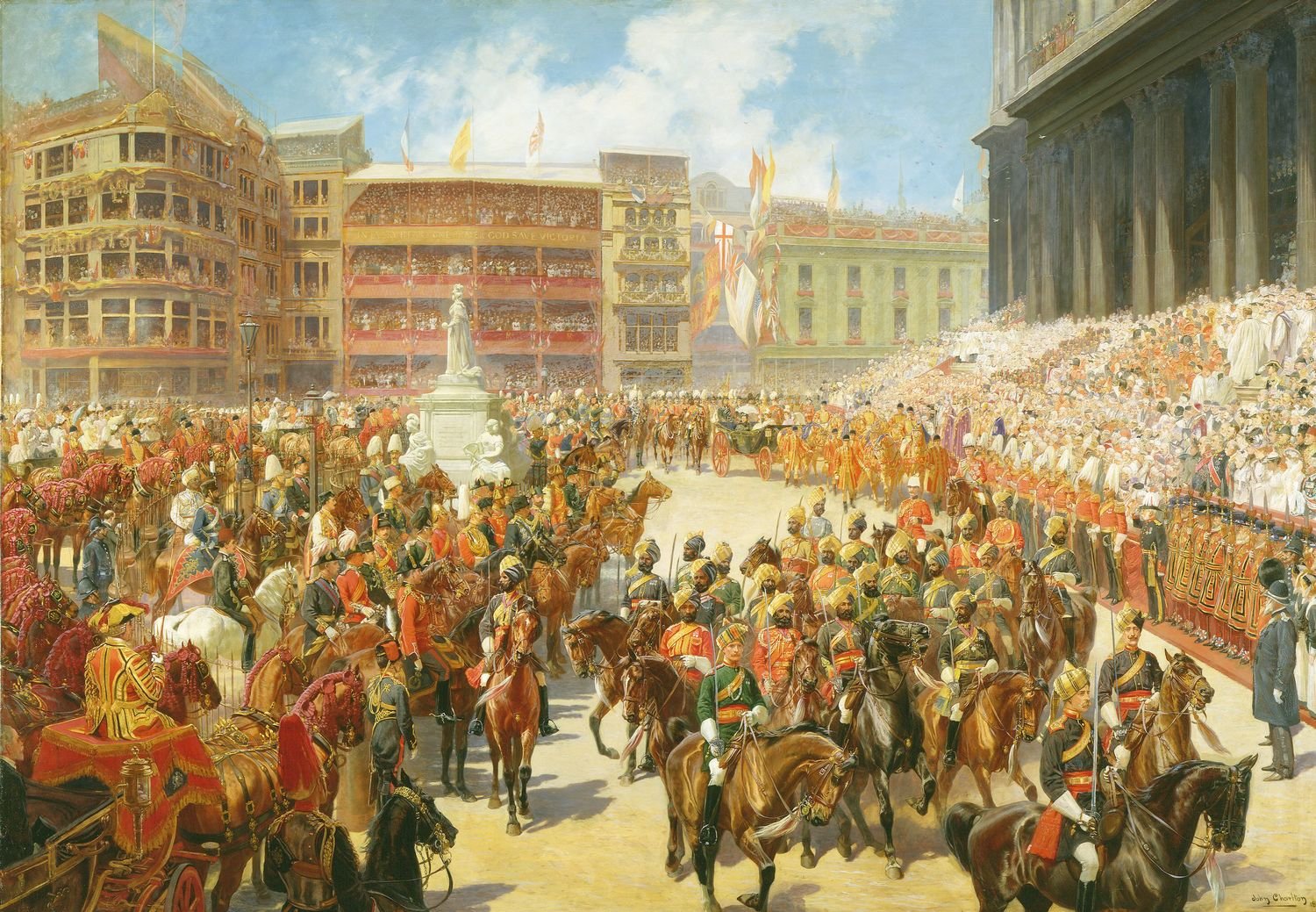
Royal Jubilees
Milestone years have been celebrated in long reigns since George III
JOHN CHARLTON (1849-1917)
'God Save The Queen': Queen Victoria arriving at St Paul's Cathedral on the occasion of the Diamond Jubilee Thanksgiving Service, 22 June 1897
Signed and dated 1897-9RCIN 400211
As part of the celebration of her Diamond Jubilee, Queen Victoria drove through London on 22 June 1897 with the purpose of seeing her people and receiving their congratulations. In this depiction of the scene Queen Victoria can be seen in an open State landau in the middle distance arriving at St Paul’s Cathedral, seated with the Princess of Wales and Princess Helena. The carriage is preceded by a cavalry escort, which included both Indian Cavalry Corps and Imperial Service Troops, with a range of contingents including (but not limited to) the Bengal and Kashmir Lancers.
At the foot of the steps in front of the Cathedral are the Honorable Corps of Gentlemen at Arms, and the Warders of the Tower of London, with members of the city Police, Ambulance Corps and New South Wales police in front of the congregation who can be seen massed on the steps. The Archbishop of Canterbury and Archbishop of York, identifiable in their purple robes, wait to greet the monarch. The congregation on the steps also includes the officiating clergy and members of the Diplomatic corps (including Ambassadors from Russia, America, France, China and Brazil) together with representatives from various other religious denominations, universities, the Bar, the City of London and other civic bodies. The statue of Queen Anne can be seen in the centre, and on the far left are members of the advance Carriage Procession drawn up and facing the Cathedral – occupants include the Empress Frederick, and Prince Edward of York. The artist himself can be seen sketching on the left behind the rail and standing next to a police officer.
Charlton was commissioned by Queen Victoria to depict the event, and was given special permission to move up and down the processional route to gain an in-depth view of the proceedings and see the uniforms of the various individuals in detail. He made numerous sketches from various points of view which were then submitted to Queen Victoria, who selected the moment of the arrival at St Paul’s as the subject for the final painting.
The Times newspaper reported the occasion thus: ‘the Queen and Empress of a great kingdom and of a huge Empire, preceded first by a procession representing the political and military strength of dominions, colonies and dependencies, and then by a military and royal procession of unparalleled grandeur, has successfully made an un-exampled progress through the greatest city of the world between enthusiastic crowds of her subjects, and before visitors from all quarters of the earth’. The Queen herself described it in her Journal as ‘A never-to-be-forgotten day’.
The painting was exhibited at the Royal Academy in 1899.
Signed and dated: John Charlton / 1899.
At the foot of the steps in front of the Cathedral are the Honorable Corps of Gentlemen at Arms, and the Warders of the Tower of London, with members of the city Police, Ambulance Corps and New South Wales police in front of the congregation who can be seen massed on the steps. The Archbishop of Canterbury and Archbishop of York, identifiable in their purple robes, wait to greet the monarch. The congregation on the steps also includes the officiating clergy and members of the Diplomatic corps (including Ambassadors from Russia, America, France, China and Brazil) together with representatives from various other religious denominations, universities, the Bar, the City of London and other civic bodies. The statue of Queen Anne can be seen in the centre, and on the far left are members of the advance Carriage Procession drawn up and facing the Cathedral – occupants include the Empress Frederick, and Prince Edward of York. The artist himself can be seen sketching on the left behind the rail and standing next to a police officer.
Charlton was commissioned by Queen Victoria to depict the event, and was given special permission to move up and down the processional route to gain an in-depth view of the proceedings and see the uniforms of the various individuals in detail. He made numerous sketches from various points of view which were then submitted to Queen Victoria, who selected the moment of the arrival at St Paul’s as the subject for the final painting.
The Times newspaper reported the occasion thus: ‘the Queen and Empress of a great kingdom and of a huge Empire, preceded first by a procession representing the political and military strength of dominions, colonies and dependencies, and then by a military and royal procession of unparalleled grandeur, has successfully made an un-exampled progress through the greatest city of the world between enthusiastic crowds of her subjects, and before visitors from all quarters of the earth’. The Queen herself described it in her Journal as ‘A never-to-be-forgotten day’.
The painting was exhibited at the Royal Academy in 1899.
Signed and dated: John Charlton / 1899.







